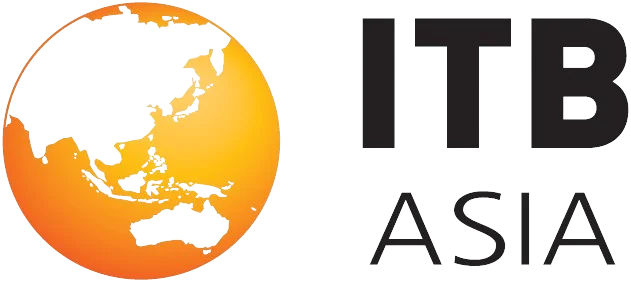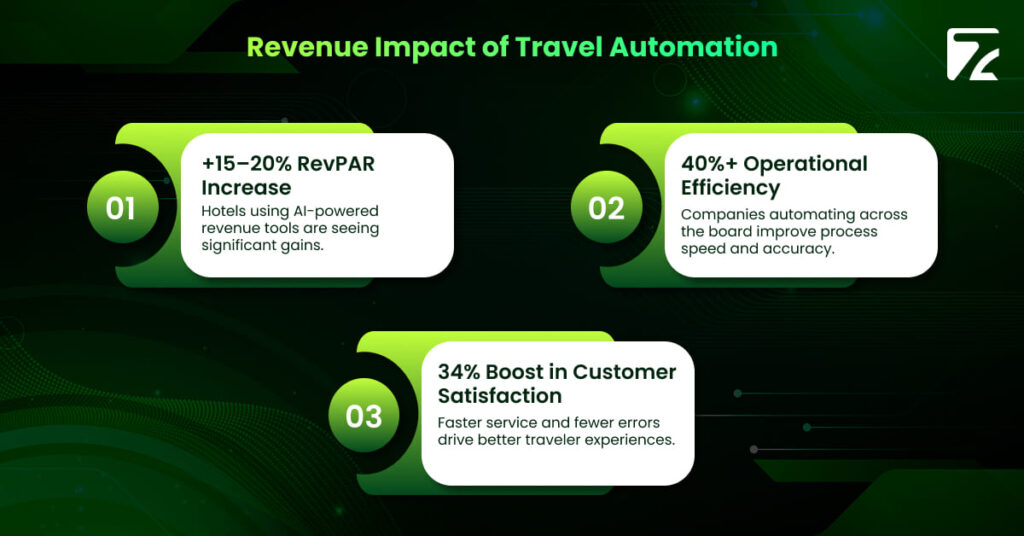
15-17 Oct

4 – 6 Nov 2025
It’s 2025, and automation in the travel world isn’t just a trend anymore it’s the new normal. Technologies have evolved at such a rapid pace that businesses have had to rethink the way they work, and travelers? They’re experiencing journeys in ways that would’ve seemed impossible a few years ago. For instance, American Airlines now expects platforms to be NDC-enabled, and Changi Airport in Singapore is gearing up to automate nearly all of its immigration checks 95% by 2026.
So at this point, it’s not really about deciding whether automation is necessary. That ship has sailed. The real challenge now is picking the right tools the ones that don’t just keep you in the game, but put you ahead.
In this guide, we’re getting into the real stuff: what automation actually looks like for travel businesses in 2025. From hands-on use cases and actual vendor setups to outcomes that show tangible gains, this is your look at what’s setting today’s best apart from the rest.

If you’re wondering whether automation is worth the investment in the travel space, the numbers paint a pretty convincing picture. Hotels using automated revenue tools are seeing jumps in RevPAR anywhere between 15% and 20%, depending on how well it’s implemented. That’s a meaningful boost, especially in a market this competitive.
Expense handling has changed, too. What once took hours and cost around $58 for every report is now handled almost instantly. Automation cuts that down to a few minutes, tops, without compromising accuracy.
And when companies really commit to these systems across the board? They’re not just saving time they’re seeing over 40% improvements in how things run. On top of that, customer satisfaction is going up as well, sometimes by as much as 34%. So yeah, it’s not just hype automation, when used right, brings real, measurable returns.
NDC might be the biggest shake-up in airline distribution we’ve seen since GDSs came on the scene. And in 2025, it’s not just gaining traction it’s everywhere. More than 60% of airlines are on board, and heavyweights like Lufthansa, Emirates, and American Airlines? They’re now offering certain fares and extras only through NDC channels. In other words, if you’re not set up for NDC, you’re missing out.
NDC setup isn’t always smooth. You’ve got to think about how it fits with your existing systems, especially when it comes to after-sales stuff like ticket changes and refunds. Most of the smart implementations combine aggregator platforms for broad airline access with direct pipes to the big-volume routes. That mix makes it easier to service customers completely, no matter what they need to adjust.
Revenue management isn’t just about guessing demand anymore. In 2025, it’s turned into a full-blown strategy that looks at every corner of a property’s potential income. Hotels aren’t just using AI to keep up, they’re using it to stay ahead. The top systems out there? They’re running millions of pricing calculations daily, and the numbers show they’re making a real difference.
If you’re running a large hotel or a resort, this one’s built with you in mind. It uses an open pricing model so you can tweak rates for different segments independently. It’s got predictive analytics running in real time and fits smoothly with tools like Demand 360 and Lighthouse. Hoteliers love it too; in fact, it snagged the top spot in the 2025 HotelTech Awards.
This one digs deep into automation, especially when it comes to pricing for groups. It’s laid out with a centralized dashboard, but you still get flexibility at each property. And with two-way PMS integration, you can push complex pricing setups without manual effort.
Atomize uses AI to model demand as it happens, adjusting prices in the moment. It’s earned a solid 93% recommendation rate, with properties reporting RevPAR lifts between 10% and 20%. And bonus it automates so much that some properties save over 30 hours a month on pricing tasks.
Ranked #2 in the 2025 HotelTech Awards overall, and the favorite among small and mid-sized hotels. It’s almost fully automated and most users only need to log in a few hours a week. Pricing starts at $142 a month, and the full-feature package goes up to $479.
This one’s trying something different. Instead of just RevPAR, it looks at RevPAG revenue per available guest. That shift helps properties focus on actual guest-level profitability. It tracks things like ADR and RevPAR in real time, adjusting pricing dynamically across channels. The tech is AI-driven too, built around optimizing the entire guest journey from start to finish.
The days of passing travel info from one system to another and hoping nothing breaks along the way are finally wrapping up. In 2025, the smartest companies are using platforms that let booking, expenses, and policy enforcement run side by side without missing a beat.
Think of it like a travel booking tool with the soul of a finance manager. It’s designed to be easy, almost like something you’d use to plan a personal trip, but under the hood, it’s packing serious features. You get direct access to huge inventories, auto-generated expense reports, real-time travel alerts, and even automatic VAT recovery. Oh and they grabbed a spot on Newsweek’s 2023 travel tech list and secured $100M in Series D funding. So yeah, they’re not small-time.
For large companies with lots of moving parts, this is often the go-to. It connects everything booking, expenses, invoicing and ties in tightly with finance systems. Reports are rich with detail, and approval workflows can be set up to match just about any internal process. It’s all about keeping things smooth and accountable.
Navan brings AI into the mix, making real-time decisions about travel that still fit company policies. Once a booking is made, expenses are handled automatically. Managers like it because they can book or approve trips in minutes and always know exactly where the money’s going.
This one runs on Spotnana’s engine, and it’s all about automation. Receipts from airlines and thousands of vendors show up on their own. Everything gets categorized without lifting a finger. And the corporate cards? Fully tied in so finance has total visibility at all times.
If you’re after simplicity, BILL offers a no-fee setup that includes built-in corporate cards and smart approval flows. Budgets are tracked in real time, and their dashboard makes it easy to keep things under control. Plus, it syncs smoothly with accounting platforms, so reconciliation doesn’t become a headache later.
By 2025, facial recognition is no longer something being quietly tested in a few terminals it’s already embedded in day-to-day airport operations. You might not see big headlines about it, but it’s there, running behind the scenes. It checks identities faster, adds a new layer of security, and honestly, changes the way the airport experience flows even if most travelers don’t realize it.
Their facial recognition solutions are rolling out across several airports in North America this year. They verify faster sometimes up to 5x and plug directly into existing infrastructure, while catching fraud more efficiently.
Offers multi-biometric options, including facial, fingerprint, and iris scanning. Their system includes smart anti-spoofing and is designed in the cloud, so it scales easily even to millions of IDs per day.
RPA isn’t what it used to be. It started off automating small, repetitive steps basic stuff. But now? It’s doing heavy lifting in the background, connecting systems, coordinating actions, and doing it faster than teams of people could manage manually. In travel, where timing and precision really matter, that kind of tech changes everything.
UiPath is everywhere these days, especially in travel. Some companies use it to run bots alongside staff others let the bots handle tasks completely on their own. AI now plays a role too, helping bots make real-time choices. The system connects directly to GDS platforms and booking tools, so there’s less back-and-forth needed. Many teams using it have cut their manual work for PNRs by more than 80%.
This one works a bit differently. It’s set up as a cloud-based service where companies can run bots without having to install much themselves. It blends automation with AI particularly good for working through messy documents like invoices. It can scale, too. Some travel teams are running hundreds or even thousands of bots in parallel without any slowdown.
Bots now handle tasks like entering, changing, or canceling bookings. They work quickly and don’t make many errors over 99.5% accuracy is common. Most of the time, they’re finishing jobs about ten times faster than a human would.
Invoices are getting generated automatically, even in different currencies. Bots are handling exchange rates, sending payments to vendors, and managing tax reporting. All of that used to take hours. Now it happens in real time.
These days, travel chatbots don’t just answer basic questions. A lot of them have grown into fully capable conversational AI systems handling bookings, making changes, and even solving support issues without skipping a beat. They’re faster, more consistent, and, surprisingly often, they sound pretty close to human.
This one comes already trained on billions of customer interactions. That gives it a huge head start when it comes to tone and timing. It uses generative AI to craft replies and checks the customer’s mood as it goes. It’s tied into a single workspace for agents and knows when to escalate a conversation. It also works in different languages, and what’s cool it keeps context even as languages switch mid-thread.
Yellow’s platform leans on ease of use. You get over 150 ready-made templates and a builder that’s mostly drag-and-drop. It supports email, Messenger, WhatsApp, SMS all in one place. And everything’s tracked in real time, which helps teams adjust and improve how the bots respond.
Zeal Connects AI was built with travel businesses in mind not as a generic chatbot, but as a practical tool that actually fits how this industry runs. It handles everything from booking reconfirmations to mid-trip changes, and it’s surprisingly good at catching issues before they become problems. What really makes it work? When the automation reaches its limit, Zeal’s support team steps in instantly, without dropping the ball. It runs smoothly across chat, email, and apps like WhatsApp, and the setup doesn’t require reworking your entire system. For teams dealing with a high volume of bookings, it’s been a huge time-saver and an easy win.
In hotels today, a lot of the tech working in the background isn’t visible but it’s doing a lot. With IoT, buildings can now react on their own. That might mean adjusting the air conditioning when a guest leaves the room, or dimming lights based on the time of day. These systems help cut costs without anyone needing to lift a finger.
At the Hawaiian Whaler, after setting up Honeywell’s smart energy setup, they saw about 30% shaved off their energy bills within eight months. It all comes from connected sensors and automation. HVAC systems respond to whether guests are present or not, no one has to think about it.
At Hotel Mera Mare, they saw a 13% drop in energy use right in the middle of the COVID slowdown. The platform tracks everything in real time and can even predict when something might fail. It connects with hotel software too, so you can control room settings remotely or automatically.
Running a travel agency isn’t just about selling trips anymore it’s about keeping every part of the business connected. That means booking systems, customer data, and financials all working as one. The newer platforms on the market are starting to get that right. They bring everything together so teams spend less time switching between tools and more time actually helping travelers.
This one’s geared toward agencies, DMCs, and tour operators who want to build customized trips. It handles dynamic pricing, costing, and budget tracking without needing extra steps. Agencies can also upload their own supplier catalogs and spin up small websites for clients. Plans start at $139/month, with tailored pricing available for larger businesses.
Lemax covers a lot. It’s built to manage bookings end-to-end and includes tools to automate both sales and operations. It connects with outside platforms and handles financial workflows in the background. Real-time inventory and multi-channel distribution are part of the package too.
This one is all about saving time. It cuts down back-office tasks with automation and helps manage payments, commissions, and financial processes. There’s also reporting built in, so agencies can track how things are performing without digging through spreadsheets.
Environmental tracking in travel isn’t something that gets pulled out once a year for a report anymore. It’s part of how companies run. Carbon data is being captured as trips are booked, and systems are starting to do a lot of the thinking that used to happen after the fact.
Now, when a booking’s made, the system can immediately calculate the carbon footprint tied to it. The numbers show up during the booking process. Behind the scenes, it’s also building out sustainability dashboards that update on their own. Some platforms will even suggest better options lower-emission alternatives using AI to pick routes or transport methods that cut down impact.
Start with a tech audit what systems are in place, what connects easily, and what needs to change. Look at how your data is structured, whether it lines up across systems, and flag anything that doesn’t. You’ll also want to check how secure things are now and spot any gaps before you automate.
Make sure whatever tools you pick can talk to what you already use API support is key. They should also scale as your business grows. Don’t overlook training and the support you’ll need to get staff on board. And remember: think about the total cost, not just the setup fees.
Begin with high-volume manual work. That’s where RPA gives you the fastest wins. At the same time, plug in a revenue management system and hook it into your PMS so pricing gets smarter. You can also roll out a basic chatbot to handle the usual customer questions.
Set up APIs to make the systems work together, and be sure data moves cleanly between them. Expect a few snags build in ways to handle errors. Train your teams early and give them docs they’ll actually use.
Now it’s time to roll in AI. Use predictive tools for forecasting demand. Improve your chatbot with better natural language features so it can handle more without human backup. If you’re using IoT devices, start syncing them into your building systems.
Watch how things are working in real time and make small adjustments. Run A/B tests to see which automations are doing the job better. And set up dashboards that actually show what’s happening no more guessing.
Automation in travel isn’t something we’re preparing for it’s here. Right now. Businesses that have started integrating it are already seeing what it can do. Some are pulling in more revenue, running things more efficiently, and keeping their customers happy without needing to expand teams.
What helps them stand out?
The companies doing this well? They’re the ones staying ahead. The tools are ready. The results are real. And the only thing slowing teams down is waiting too long to start.
So if you’re planning to compete seriously in 2025 and beyond, now’s the time to move. Start with the stuff that’s slowing you down. Line up the right tools. And begin. The advantage doesn’t go to the biggest, it goes to the first ones who take action.
NDC platforms, AI revenue management systems, corporate travel platforms, biometric airport tech, and RPA bots are streamlining operations and boosting ROI across the industry.
NDC enables access to exclusive airline content, personalized offers, and automates booking changes, refunds, and ancillaries improving revenue and efficiency.
Hotels see 15–20% RevPAR growth, 30+ hours/month in time savings, and improved pricing accuracy with tools like Duetto, IDeaS, and RoomPriceGenie.
They offer faster check-ins, personalized room settings, and energy savings cutting airport processing times by 75% and reducing hotel energy use by up to 30%.
Start with a tech audit, deploy high-impact automation (RPA/chatbots), integrate systems via APIs, and scale with AI and IoT measuring success through KPIs.

Travel Automation Expert